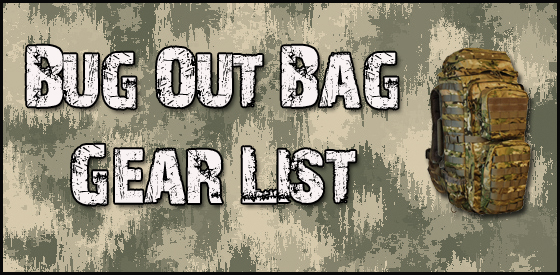So, when it came to survival tips, I talked about having a "Bug-Out Bag," or a bag maintained and always ready to go that would be able to last you at least 72 hours (or three days), just in case.

So, what exactly should you have in your "Bug-Out Bag?" Everyone has their own answers and tweaks their own to their own desires, but there are specific things you should have standard:
- Water - at least three liters, at the bare minimum (three gallons is even better!) - To increase your chance of survival past three days, it is good to have a water purification system ready to go; which can be as easy as iodine tablets (remember 2 tablets for every 1 liter of water). You can also pack a collapsible water bottle and/ or a backpack bucket. Coffee filters can extend the life of your purification system, and make sure to save your bottles if you plan to have bottled water in your bag. Stainless steel canteens are also a good idea.
- Food - Backpack meals (freeze-dried meals that you add boiling water to) and energy bars are sufficient and both last a long time. MREs are also great (shelf life of three years), if you have access to them.
- Clothing -
- A pair of sturdy boots or shoes (remember boots are always preferred because of protection and stability)
- A pair of long pants (preferably not blue jeans)
- 2 pairs of socks - hiking (preferably not cotton)
- 2 shirts (maybe one long sleeve and one short sleeve for layering)
- A jacket that is both warm and protection from rain
- Warm, long underwear of some kind
- A hat
- A bandanna
- Shelter -
- Some type of tarp or tent and a way to set it up
- A ground tarp or sleeping pad for underneath to stay dry (never underestimate the importance of this)
- Some kind of bedroll, preferably a good sleeping bag
- First Aid Kit - preferably built by you, most of the prepackaged ones have a bunch of stuff you wouldn't need. You can even add a Sawyer Extractor for poisonous snake and insect bites. Remember the anti-diarrhea medicine (which can be life-or-death if stranded)!
- Remember The Basics -
- Rain Gear - have at least two ways to stay dry; poncho and coat are good coupled with your tarp or tent.
- Fire - Have at least 5 ways to make a fire and 5 ideas for fire tender. It's even a good idea to have a good, light-weight cutting tool besides your knife/knives, like a survival chainsaw.
- Cooking - Bare minimum a small pot/large cup to boil water in. A small backpacking stove and fuel are obviously better.
- Light - At least 2 dependable flash lights and back up batteries for each - hand-cranked flash lights work as well (glow sticks are a good idea for a backup).
- Survival Knife - or two!
- Weapon - your choice of some sort of firearm and ammo.
- Also, if you can fit them, hygiene products (toilet paper, etc.) don't hurt!
- A disaster plan (if applicable), a professional survival book, a compass, a whistle, flares, some sort of rope/cord, a signal mirror, emergency blankets (to keep in warmth), a battery-operated or hand-crank radio/C.B. or Ham radio, bug repellent, sun block, a camp ax and shovel, a multi-tool, a bottle of multi-vitamins, fishing lures and line, Ziploc bags, and duct tape are all other very good ideas.
Like I said, these are just the basics (from the bare minimum to the more elaborate), and there are plenty of other things you can add to make things more comfortable - just remember that you could be traveling great distances. You can check out a few of them here. Good luck!
No comments:
Post a Comment
Thanks for reading Blue Sky Days! XOXO, Kyrstie.